Abstract
Interleukin-4 is a T lymphocyte- and mast cell-derived cytokine with pleiotropic properties with biological effects on a variety of target cells including B and T lymphocytes, macrophages, hematopoietic cells, mast cells, and fibroblasts. In addition to the proliferation effect of IL-4 on fibroblasts, which has been previously described, in this report the chemotactic properties of IL-4 for fibroblasts is described. Human recombinant IL-4 induced the chemotactic migration of dermal fibroblasts in vitro in modified Boyden-type chambers at concentrations between 10(-12) and 10(-11) M. The chemotactic activity of IL-4 was neutralized by anti-human recombinant IL-4 IgG antibodies. Oligopeptides representing the complete deduced amino acid sequence of human IL-4 were synthesized by the Merrifield technique and tested for their ability to induce fibroblast chemotaxis. Two peptides representing residues 70-88 and 89-122 induced fibroblast migration. Peptide 70-88 was the more potent of the two causing chemotaxis of fibroblasts at 10(-8)-10(-6) M while peptide 89-129 induced migration at 10(-7)-10(-5) M. Although the mechanism by which IL-4 and these two peptides induce fibroblast chemotaxis is unknown, each of these three compounds were able to chemotactically desensitize fibroblasts to the chemotactic effects of the other two but not to a structurally unrelated chemotactic cytokine, transforming growth factor beta-1. These studies suggest that IL-4 might function in vivo to induce the accumulation of fibroblasts at sites of tissue injury, inflammatory and immune reactions in which T lymphocytes and mast cells participate.
Full text
PDF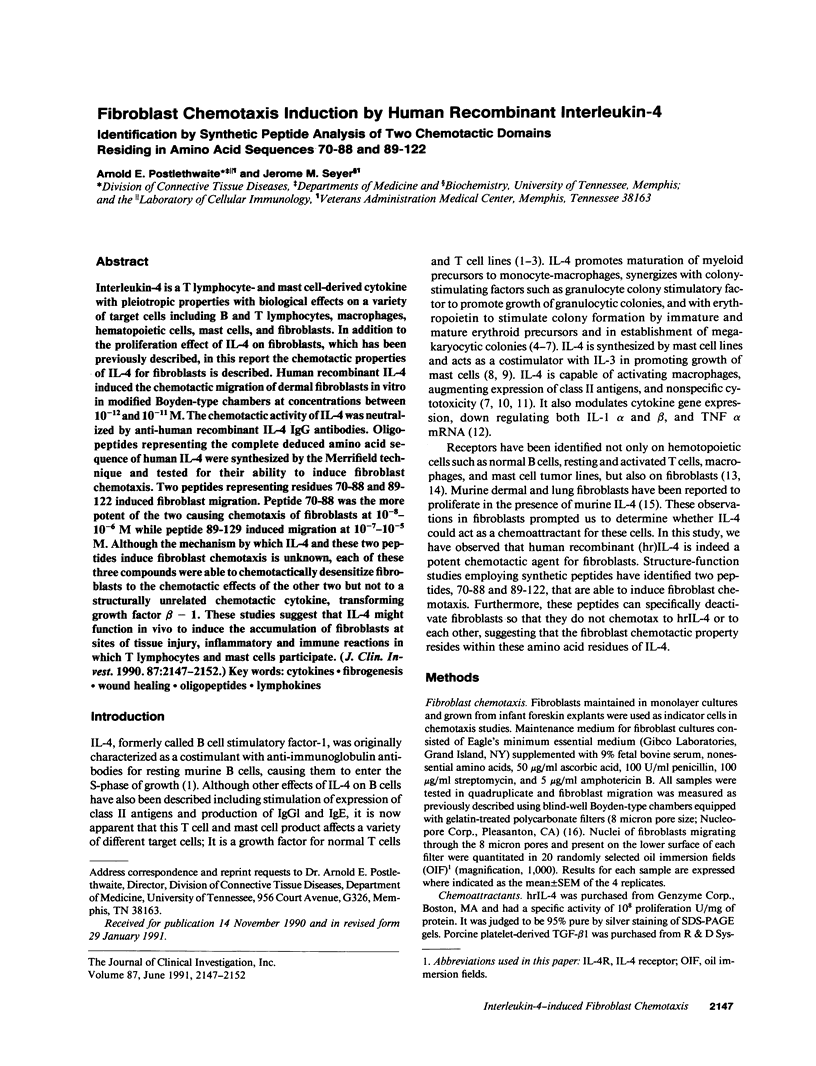
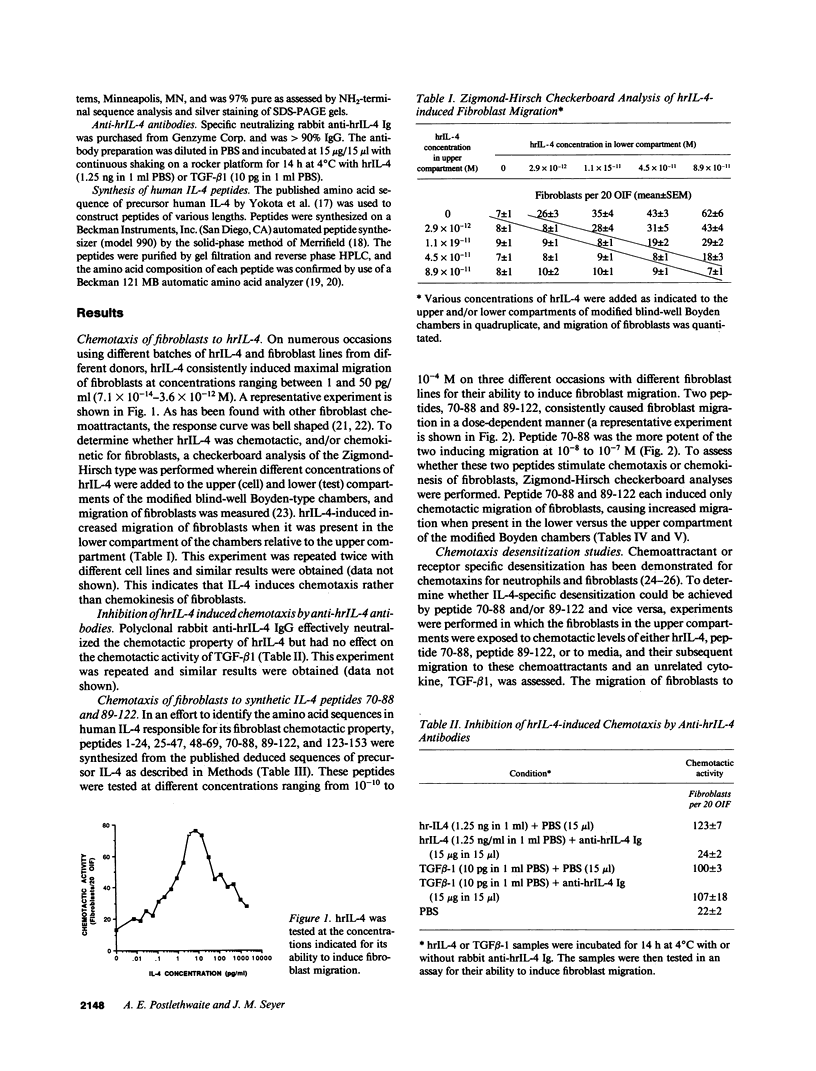
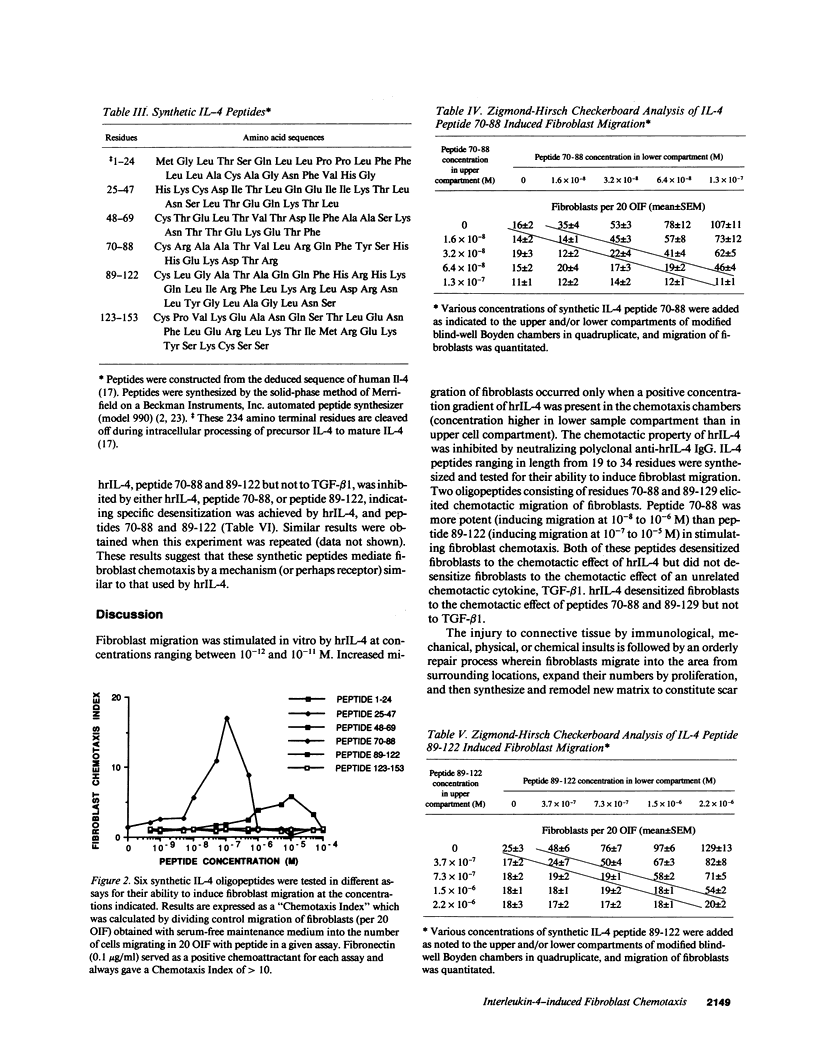
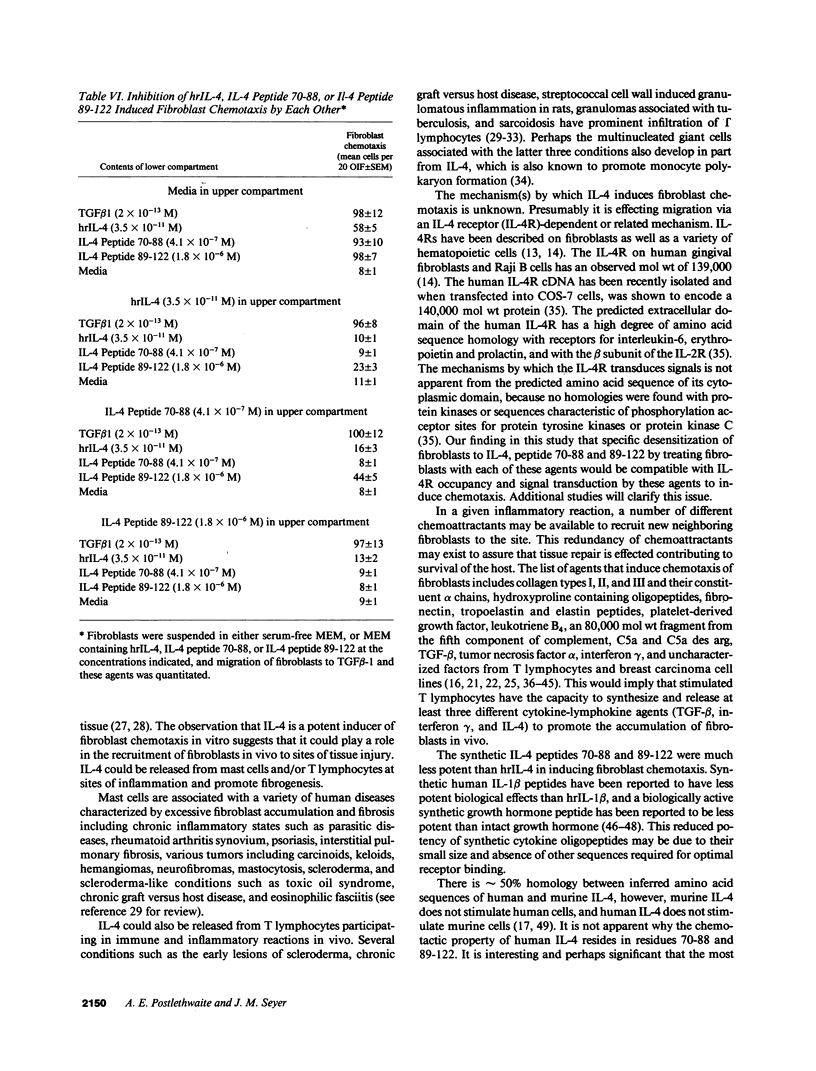
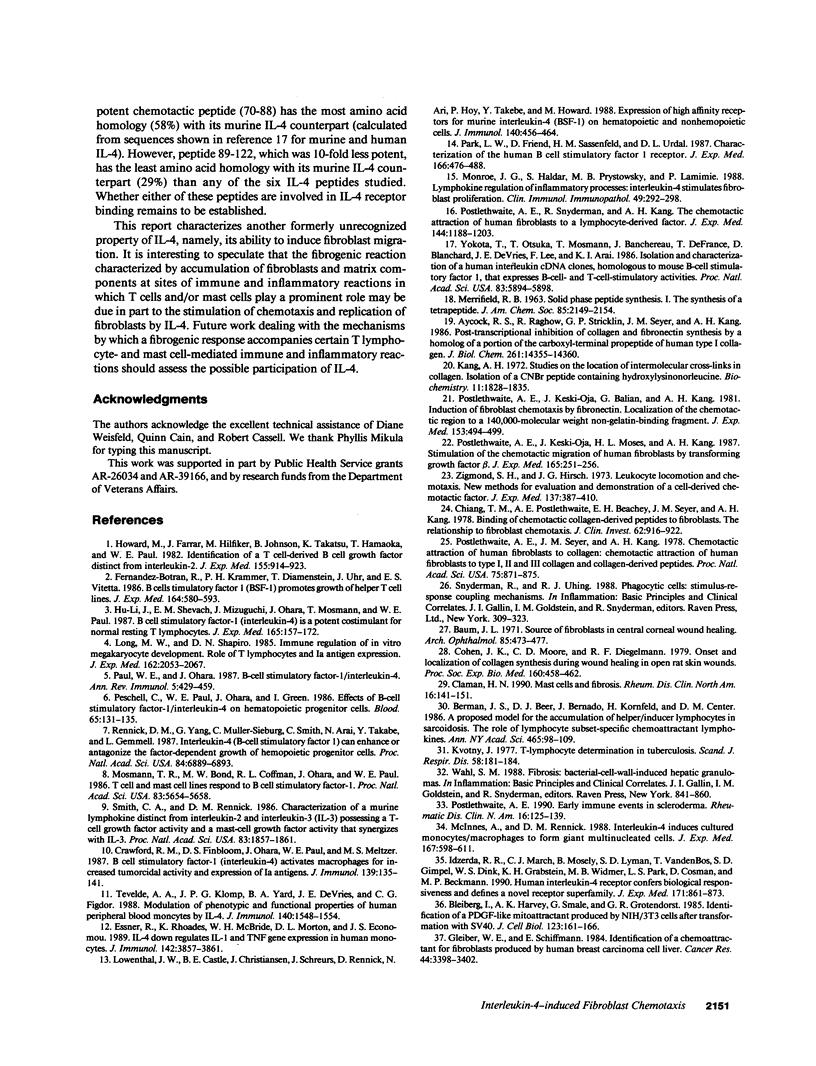

Selected References
These references are in PubMed. This may not be the complete list of references from this article.
- Antoni G., Presentini R., Perin F., Tagliabue A., Ghiara P., Censini S., Volpini G., Villa L., Boraschi D. A short synthetic peptide fragment of human interleukin 1 with immunostimulatory but not inflammatory activity. J Immunol. 1986 Nov 15;137(10):3201–3204. [PubMed] [Google Scholar]
- Aycock R. S., Raghow R., Stricklin G. P., Seyer J. M., Kang A. H. Post-transcriptional inhibition of collagen and fibronectin synthesis by a synthetic homolog of a portion of the carboxyl-terminal propeptide of human type I collagen. J Biol Chem. 1986 Oct 25;261(30):14355–14360. [PubMed] [Google Scholar]
- Baum J. L. Source of the fibroblast in central corneal wound healing. Arch Ophthalmol. 1971 Apr;85(4):473–477. doi: 10.1001/archopht.1971.00990050475014. [DOI] [PubMed] [Google Scholar]
- Berman J. S., Beer D. J., Bernardo J., Kornfeld H., Center D. M. A proposed model for the accumulation of helper/inducer lymphocytes in sarcoidosis. The role of lymphocyte subset-specific chemoattractant lymphokines. Ann N Y Acad Sci. 1986;465:98–109. doi: 10.1111/j.1749-6632.1986.tb18485.x. [DOI] [PubMed] [Google Scholar]
- Bleiberg I., Harvey A. K., Smale G., Grotendorst G. R. Identification of a PDGF-like mitoattractant produced by NIH/3T3 cells after transformation with SV40. J Cell Physiol. 1985 May;123(2):161–166. doi: 10.1002/jcp.1041230203. [DOI] [PubMed] [Google Scholar]
- Chiang T. M., Postlethwaite A. E., Beachey E. H., Seyer J. M., Kang A. H. Binding of chemotactic collagen-derived peptides to fibroblasts. The relationship to fibroblast chemotaxis. J Clin Invest. 1978 Nov;62(5):916–922. doi: 10.1172/JCI109219. [DOI] [PMC free article] [PubMed] [Google Scholar]
- Claman H. N. Mast cells and fibrosis. The relevance to scleroderma. Rheum Dis Clin North Am. 1990 Feb;16(1):141–151. [PubMed] [Google Scholar]
- Cohen I. K., Moore C. D., Diegelmann R. F. Onset and localization of collagen synthesis during wound healing in open rat skin wounds. Proc Soc Exp Biol Med. 1979 Apr;160(4):458–462. doi: 10.3181/00379727-160-40470. [DOI] [PubMed] [Google Scholar]
- Crawford R. M., Finbloom D. S., Ohara J., Paul W. E., Meltzer M. S. B cell stimulatory factor-1 (interleukin 4) activates macrophages for increased tumoricidal activity and expression of Ia antigens. J Immunol. 1987 Jul 1;139(1):135–141. [PubMed] [Google Scholar]
- Edén S., Kostyo J. L., Schwartz J. Ability of growth hormone fragments to complete with 125I-iodinated human growth hormone for specific binding to isolated adipocytes of hypophysectomized rats. Biochim Biophys Acta. 1982 Dec 30;721(4):489–491. doi: 10.1016/0167-4889(82)90106-9. [DOI] [PubMed] [Google Scholar]
- Essner R., Rhoades K., McBride W. H., Morton D. L., Economou J. S. IL-4 down-regulates IL-1 and TNF gene expression in human monocytes. J Immunol. 1989 Jun 1;142(11):3857–3861. [PubMed] [Google Scholar]
- Fernandez-Botran R., Krammer P. H., Diamantstein T., Uhr J. W., Vitetta E. S. B cell-stimulatory factor 1 (BSF-1) promotes growth of helper T cell lines. J Exp Med. 1986 Aug 1;164(2):580–593. doi: 10.1084/jem.164.2.580. [DOI] [PMC free article] [PubMed] [Google Scholar]
- Gleiber W. E., Schiffmann E. Identification of a chemoattractant for fibroblasts produced by human breast carcinoma cell lines. Cancer Res. 1984 Aug;44(8):3398–3402. [PubMed] [Google Scholar]
- Howard M., Farrar J., Hilfiker M., Johnson B., Takatsu K., Hamaoka T., Paul W. E. Identification of a T cell-derived b cell growth factor distinct from interleukin 2. J Exp Med. 1982 Mar 1;155(3):914–923. doi: 10.1084/jem.155.3.914. [DOI] [PMC free article] [PubMed] [Google Scholar]
- Hu-Li J., Shevach E. M., Mizuguchi J., Ohara J., Mosmann T., Paul W. E. B cell stimulatory factor 1 (interleukin 4) is a potent costimulant for normal resting T lymphocytes. J Exp Med. 1987 Jan 1;165(1):157–172. doi: 10.1084/jem.165.1.157. [DOI] [PMC free article] [PubMed] [Google Scholar]
- Idzerda R. L., March C. J., Mosley B., Lyman S. D., Vanden Bos T., Gimpel S. D., Din W. S., Grabstein K. H., Widmer M. B., Park L. S. Human interleukin 4 receptor confers biological responsiveness and defines a novel receptor superfamily. J Exp Med. 1990 Mar 1;171(3):861–873. doi: 10.1084/jem.171.3.861. [DOI] [PMC free article] [PubMed] [Google Scholar]
- Kang A. H. Studies on the location of intermolecular cross-links in collagen. Isolation of a CNBr peptide containing -hydroxylysinonorleucine. Biochemistry. 1972 May 9;11(10):1828–1835. doi: 10.1021/bi00760a015. [DOI] [PubMed] [Google Scholar]
- Kvetny J. T-lymphocyte determination in tuberculosis. Scand J Respir Dis. 1977 Jun;58(3):181–184. [PubMed] [Google Scholar]
- Long M. W., Shapiro D. N. Immune regulation of in vitro murine megakaryocyte development. Role of T lymphocytes and Ia antigen expression. J Exp Med. 1985 Dec 1;162(6):2053–2067. doi: 10.1084/jem.162.6.2053. [DOI] [PMC free article] [PubMed] [Google Scholar]
- Lowenthal J. W., Castle B. E., Christiansen J., Schreurs J., Rennick D., Arai N., Hoy P., Takebe Y., Howard M. Expression of high affinity receptors for murine interleukin 4 (BSF-1) on hemopoietic and nonhemopoietic cells. J Immunol. 1988 Jan 15;140(2):456–464. [PubMed] [Google Scholar]
- McInnes A., Rennick D. M. Interleukin 4 induces cultured monocytes/macrophages to form giant multinucleated cells. J Exp Med. 1988 Feb 1;167(2):598–611. doi: 10.1084/jem.167.2.598. [DOI] [PMC free article] [PubMed] [Google Scholar]
- Mensing H., Czarnetzki B. M. Leukotriene B4 induces in vitro fibroblast chemotaxis. J Invest Dermatol. 1984 Jan;82(1):9–12. doi: 10.1111/1523-1747.ep12258678. [DOI] [PubMed] [Google Scholar]
- Monroe J. G., Haldar S., Prystowsky M. B., Lammie P. Lymphokine regulation of inflammatory processes: interleukin-4 stimulates fibroblast proliferation. Clin Immunol Immunopathol. 1988 Nov;49(2):292–298. doi: 10.1016/0090-1229(88)90119-5. [DOI] [PubMed] [Google Scholar]
- Mosmann T. R., Bond M. W., Coffman R. L., Ohara J., Paul W. E. T-cell and mast cell lines respond to B-cell stimulatory factor 1. Proc Natl Acad Sci U S A. 1986 Aug;83(15):5654–5658. doi: 10.1073/pnas.83.15.5654. [DOI] [PMC free article] [PubMed] [Google Scholar]
- Noma Y., Sideras P., Naito T., Bergstedt-Lindquist S., Azuma C., Severinson E., Tanabe T., Kinashi T., Matsuda F., Yaoita Y. Cloning of cDNA encoding the murine IgG1 induction factor by a novel strategy using SP6 promoter. Nature. 1986 Feb 20;319(6055):640–646. doi: 10.1038/319640a0. [DOI] [PubMed] [Google Scholar]
- Park L. S., Friend D., Sassenfeld H. M., Urdal D. L. Characterization of the human B cell stimulatory factor 1 receptor. J Exp Med. 1987 Aug 1;166(2):476–488. doi: 10.1084/jem.166.2.476. [DOI] [PMC free article] [PubMed] [Google Scholar]
- Paul W. E., Ohara J. B-cell stimulatory factor-1/interleukin 4. Annu Rev Immunol. 1987;5:429–459. doi: 10.1146/annurev.iy.05.040187.002241. [DOI] [PubMed] [Google Scholar]
- Postlethwaite A. E. Early immune events in scleroderma. Rheum Dis Clin North Am. 1990 Feb;16(1):125–139. [PubMed] [Google Scholar]
- Postlethwaite A. E., Keski-Oja J., Balian G., Kang A. H. Induction of fibroblast chemotaxis by fibronectin. Localization of the chemotactic region to a 140,000-molecular weight non-gelatin-binding fragment. J Exp Med. 1981 Feb 1;153(2):494–499. doi: 10.1084/jem.153.2.494. [DOI] [PMC free article] [PubMed] [Google Scholar]
- Postlethwaite A. E., Keski-Oja J., Moses H. L., Kang A. H. Stimulation of the chemotactic migration of human fibroblasts by transforming growth factor beta. J Exp Med. 1987 Jan 1;165(1):251–256. doi: 10.1084/jem.165.1.251. [DOI] [PMC free article] [PubMed] [Google Scholar]
- Postlethwaite A. E., Seyer J. M., Kang A. H. Chemotactic attraction of human fibroblasts to type I, II, and III collagens and collagen-derived peptides. Proc Natl Acad Sci U S A. 1978 Feb;75(2):871–875. doi: 10.1073/pnas.75.2.871. [DOI] [PMC free article] [PubMed] [Google Scholar]
- Postlethwaite A. E., Smith G. N., Jr, Lachman L. B., Endres R. O., Poppleton H. M., Hasty K. A., Seyer J. M., Kang A. H. Stimulation of glycosaminoglycan synthesis in cultured human dermal fibroblasts by interleukin 1. Induction of hyaluronic acid synthesis by natural and recombinant interleukin 1s and synthetic interleukin 1 beta peptide 163-171. J Clin Invest. 1989 Feb;83(2):629–636. doi: 10.1172/JCI113927. [DOI] [PMC free article] [PubMed] [Google Scholar]
- Postlethwaite A. E., Snyderman R., Kang A. H. Generation of a fibroblast chemotactic factor in serum by activation of complement. J Clin Invest. 1979 Nov;64(5):1379–1385. doi: 10.1172/JCI109595. [DOI] [PMC free article] [PubMed] [Google Scholar]
- Rennick D., Yang G., Muller-Sieburg C., Smith C., Arai N., Takabe Y., Gemmell L. Interleukin 4 (B-cell stimulatory factor 1) can enhance or antagonize the factor-dependent growth of hemopoietic progenitor cells. Proc Natl Acad Sci U S A. 1987 Oct;84(19):6889–6893. doi: 10.1073/pnas.84.19.6889. [DOI] [PMC free article] [PubMed] [Google Scholar]
- Senior R. M., Griffin G. L., Mecham R. P. Chemotactic responses of fibroblasts to tropoelastin and elastin-derived peptides. J Clin Invest. 1982 Sep;70(3):614–618. doi: 10.1172/JCI110654. [DOI] [PMC free article] [PubMed] [Google Scholar]
- Senior R. M., Griffin G. L., Mecham R. P., Wrenn D. S., Prasad K. U., Urry D. W. Val-Gly-Val-Ala-Pro-Gly, a repeating peptide in elastin, is chemotactic for fibroblasts and monocytes. J Cell Biol. 1984 Sep;99(3):870–874. doi: 10.1083/jcb.99.3.870. [DOI] [PMC free article] [PubMed] [Google Scholar]
- Senior R. M., Griffin G. L., Perez H. D., Webster R. O. Human C5a and C5a des Arg exhibit chemotactic activity for fibroblasts. J Immunol. 1988 Nov 15;141(10):3570–3574. [PubMed] [Google Scholar]
- Senior R. M., Huang J. S., Griffin G. L., Deuel T. F. Dissociation of the chemotactic and mitogenic activities of platelet-derived growth factor by human neutrophil elastase. J Cell Biol. 1985 Feb;100(2):351–356. doi: 10.1083/jcb.100.2.351. [DOI] [PMC free article] [PubMed] [Google Scholar]
- Smith C. A., Rennick D. M. Characterization of a murine lymphokine distinct from interleukin 2 and interleukin 3 (IL-3) possessing a T-cell growth factor activity and a mast-cell growth factor activity that synergizes with IL-3. Proc Natl Acad Sci U S A. 1986 Mar;83(6):1857–1861. doi: 10.1073/pnas.83.6.1857. [DOI] [PMC free article] [PubMed] [Google Scholar]
- Yokota T., Otsuka T., Mosmann T., Banchereau J., DeFrance T., Blanchard D., De Vries J. E., Lee F., Arai K. Isolation and characterization of a human interleukin cDNA clone, homologous to mouse B-cell stimulatory factor 1, that expresses B-cell- and T-cell-stimulating activities. Proc Natl Acad Sci U S A. 1986 Aug;83(16):5894–5898. doi: 10.1073/pnas.83.16.5894. [DOI] [PMC free article] [PubMed] [Google Scholar]
- Zigmond S. H., Hirsch J. G. Leukocyte locomotion and chemotaxis. New methods for evaluation, and demonstration of a cell-derived chemotactic factor. J Exp Med. 1973 Feb 1;137(2):387–410. doi: 10.1084/jem.137.2.387. [DOI] [PMC free article] [PubMed] [Google Scholar]
- te Velde A. A., Klomp J. P., Yard B. A., de Vries J. E., Figdor C. G. Modulation of phenotypic and functional properties of human peripheral blood monocytes by IL-4. J Immunol. 1988 Mar 1;140(5):1548–1554. [PubMed] [Google Scholar]


